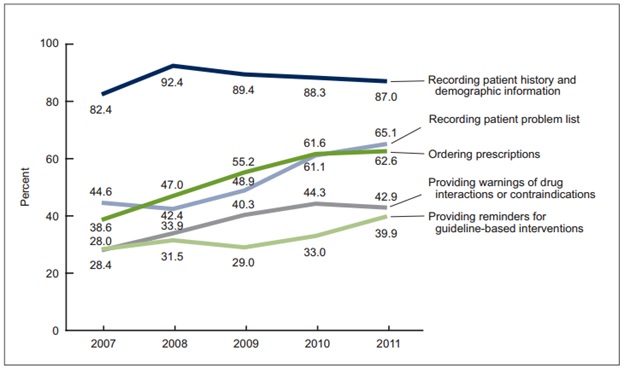In 2009 Congress passed the Health Information Technology for Economic and Clinical Health Act (HITECH). The law authorized financial incentives for medical providers that used Electronic Health Records (EHRs) for so called “meaningful use objectives”. In 2011 emergency departments (EDs) and outpatient departments (ODs) became eligible for HITECH incentives if they used EHR systems for the variety of functions including: recording patient history and demographic information, record patient problem list, ordering prescriptions, providing warnings of drug interaction or contraindications, providing reminders for guideline-based interventions. Previous research has highlighted that HITECH successfully incentivized medical providers to purchase EHR systems. New data from the Nation Center for Health Statistics shows which specific objectives EDs and ODs met with their HITECH money.
EHR adoption continues to rise after the passage of HITECH in 2009. By the time meaningful use incentives were available in 2011 about 10 percent more EDs and OPDs were using EHR systems.

Source: NCHS Data Brief
Diving into the details of which meaningful use objectives were met by EDs is revealing. The percent increases for each objective for EDs after 2009 vary considerably. The percent of EDs using EHRs for recording patient history and demographic information declined (-2.4 percent) from 2009 to 2011. There is a small increase of EDs using EHRs for providing warnings of drug interactions or contraindications (2.6 percent).
EDs with EHR technology able to support selected Stage 1 Meaningful Use objectives

Source: NCHS Data Brief
The adoption patterns for ODs differ in important ways from EDs. There are large increases in the reported use of EHR systems for each of the early HITECH objectives from 2009 to 2011. The percent of ODs using EHRs for recording patient problem lists increased by about 31 percent in the two years after the passage of HITECH. The magnitude of the change and increases in other objectives suggests that HITECH was able to successfully change record keeping at ODs.
ODs with EHR technology able to support selected Stage 1 Meaningful Use
objectives

Source: NCHS Data Brief



Commentary
Three graphs that show the impact of HITECH on Electronic Health Record Adoption
June 4, 2015